Pest management should be based on the proper identification of pests and knowledge of their biology. The major pests of tomato, pepper, and eggplant in Florida and guidelines for their management are described below. Some insects may be more important in some areas of the state than others.
For each pest described, a table of management options will be found after the damage description. Pesticides labeled for tomatoes, peppers, and eggplants for management of these pests can be found in the updated annual UF/IFAS Vegetable production Handbook.
Silverleaf Whitefly, Bemisia tabaci
http://entnemdept.ufl.edu/creatures/veg/leaf/silverleaf_whitefly.htm
Description
The adult sweetpotato whitefly (also called silverleaf whitefly) (Figure 1) is approximately 1/16 of an inch in length, and has powdery white wings held tent-like over a yellow body while at rest. Whiteflies are usually found on the undersides of leaves. Eggs, which are yellow and football-shaped, are attached upright by a tiny stalk inserted into the lower leaf surface. A mobile first instar or crawler stage hatches from the egg and settles on the leaf. It then develops through immobile second, third, and fourth instars (Figure 2), which look like semi-transparent, flat, oval scales. The fourth instar or "pupa" is more yellow and more easily seen without the aid of a hand lens, typically has very distinct eyespots, and is referred to as a "red-eyed nymph."
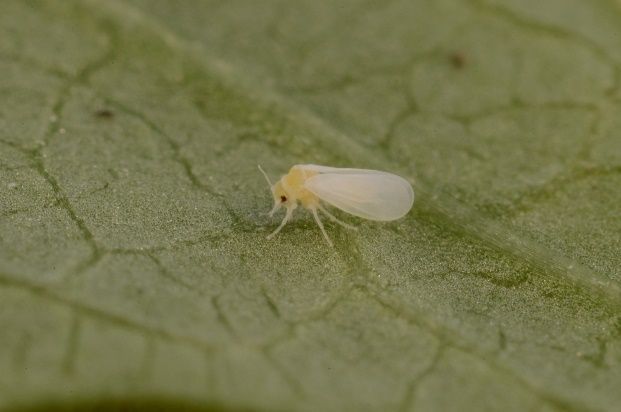
Credit: Lyle Buss, UF/IFAS
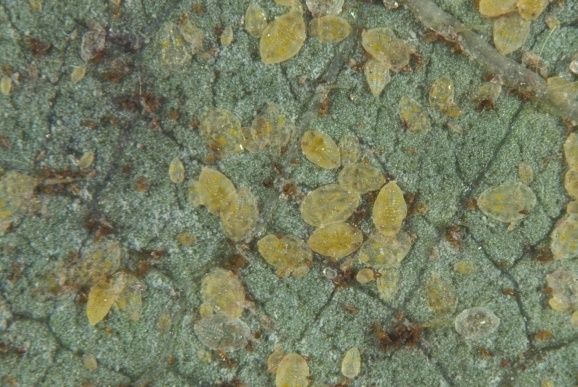
Credit: Lyle Buss, UF/IFAS
Biology
The life cycle from egg to adult can be as short as two weeks when the weather is very warm. Adult females lay most of their eggs on young leaves, so young nymphs also generally occur on the undersides of younger leaves. As the plant grows, leaves bearing the maturing nymphs are found lower down on the plant, so older nymphs can be found by looking at older leaves. Whiteflies ingest sap from the plant vascular system (phloem) through stylets similar to those of aphids and, like aphids, process a relatively large volume of plant sap by excreting excess liquid in the form of a sugary honeydew.
Damage
If abundant, whiteflies can damage plants directly by removing sap. The honeydew that they excrete while feeding serves to grow sooty mold, which can reduce the amount of light reaching leaves. Moderate numbers of nymphs can cause irregular ripening of tomatoes, characterized by incomplete ripening of longitudinal sections of fruit. Nymphal feeding also causes an increase in objectionable white tissue in interior fruit walls. Adults transmit plant viruses. After feeding on infected plants, whiteflies can then transfer the virus to healthy plants. Unlike the mosaic viruses transmitted rapidly by aphids, the whitefly-transmitted geminiviruses commonly found in tomatoes are transmitted persistently. It takes longer for the whitefly to acquire the virus, and the virus must pass through the body of the insect into the salivary glands before the whitefly can transmit it to a healthy plant. The whitefly has to feed on a healthy plant for some time to cause infection. Once the whitefly acquires the virus, it may transmit it for the rest of its life. In addition to Tomato mottle virus, the very severe Tomato yellow leaf curl virus is now commonly transmitted by whiteflies in Florida.
Silverleaf whitefly can reach high numbers on tomato and eggplant and can be a problem on peppers. Generally, whitefly populations are highest in south, southwest and west central Florida and in north Florida during the spring, although, in west central Florida, the number of whiteflies carrying virus is usually higher in the fall. Tomato yellow leaf curl virus causes problems in all tomato-growing areas in Florida.
Table 1. Whitefly management.
Aphids
http://entnemdept.ufl.edu/creatures/veg/aphid/green_peach_aphid.htm
Description and Biology
Aphids (Figure 3) are soft-bodied, sucking insects that can rapidly colonize plants due to their short generation time. Adults are delicate, pear- or spindle-shaped insects with a posterior pair of tubes (cornicles), which project upward and backward from the dorsal surface of the abdomen and can excrete a defensive fluid. In Florida, winged and wingless forms are all females that give birth to living young (nymphs). Nymphs are smaller but otherwise similar in appearance to wingless adults, which they become in 7–10 days.
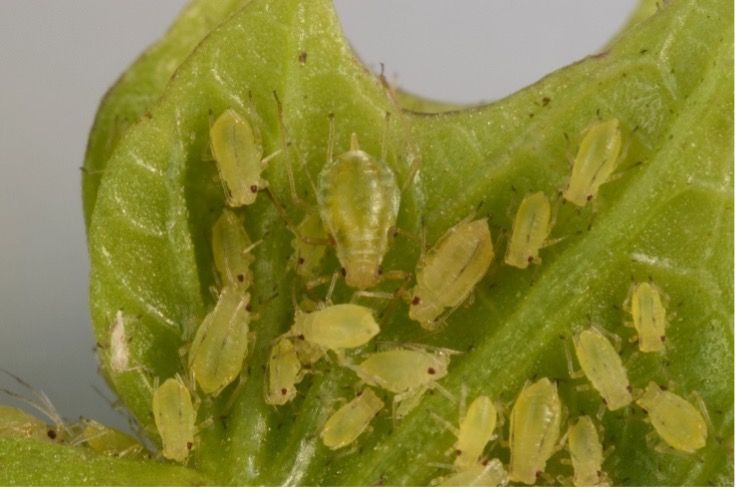
Credit: Lyle Buss, UF/IFAS
The green peach aphid, Myzus persicae, is the most common aphid species in Florida peppers and tomatoes, although the potato aphid (Macrosiphum euphorbiae) may also occur. Green peach aphid adults are pear-shaped, 0.04–0.08 inch in length, and light green to yellow and pink. The tubercles (bumps between antennae) point inward and are a distinguishing characteristic. Winged forms each have a black patch on the back of the abdomen.
Damage
Heavy aphid infestations may cause stunting and leaf distortion. Feeding on blossoms reduces fruit set. Sooty mold will grow on the honeydew that the aphids excrete. They also spread plant viruses such as Tobacco etch virus, Potato virus Y, and Pepper mottle virus. Most transmission results from winged aphids probing leaf surfaces, flying to another plant, and probing again. Aphids that settle, feed, and reproduce on the plant are less likely to transmit virus. Aphid-transmitted viruses are non-circulative, meaning they stay in the aphid’s stylet. Consequently, aphids can acquire and transmit the virus in a matter of seconds but lose the virus after probing a few plants. In this transmission mode, there is no strong specificity, and one virus can be propagated by many different species of aphids. In addition, conventional insecticides are of little help in controlling the spread of these viruses because they will mostly target aphid colonies settling on the plants. The best strategy is to sanitize the crop by removing sources of infection consisting of nearby virus-infected tomato, pepper, tobacco, or other host plants. Related weeds, such as nightshade, may also be infected and serve as a source of virus for the crop.
Table 2. Aphids management.
True Bugs (Hemiptera)
http://entnemdept.ufl.edu/creatures/veg/bean/green_stink_bug.htm
Description
Like aphids and whiteflies, true bugs are sucking insects. True bugs can be recognized by their front wings, which are leathery close to the body but membrane-like at the tips. Nymphs resemble adults in shape but are often colored differently and do not have fully developed wings. Stink bugs (Pentatomidae) (Figure 4) are green or brown shield-shaped bugs ½ inch to 2/3 inch long. Eggs are barrel-shaped and found on the undersides of leaves in masses of 10 to 50. Nymphs are similar in shape to adults but more brightly colored and patterned. Leaffooted bugs (Coreidae) (Figure 5) are dark-colored true bugs with parallel sides, 5/8 inch to ¾ inch long. Three species infest tomato in Florida, two of which have flattened hind tibia (lower legs). Eggs are metallic and ovate but somewhat flattened laterally and laid in clusters. Some leaffooted bugs lay their eggs end to end in a single row or chain along a stem or leaf midrib. Nymphs are oblong and red, especially on the abdomen.
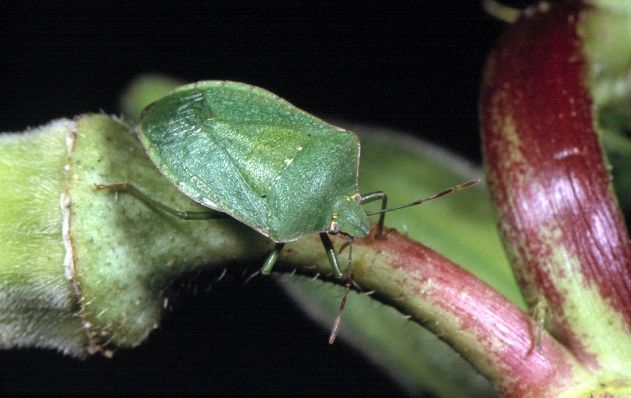
Credit: Lyle Buss, UF/IFAS
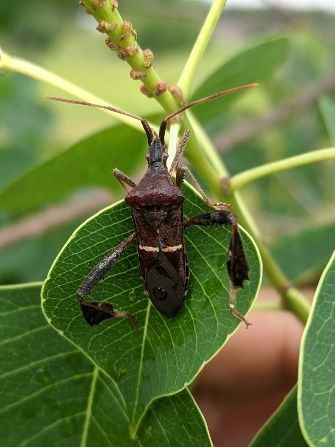
Credit: Xavier Martini
Biology
Southern green stinkbug can complete its life cycle in 65–70 days. It overwinters as an adult in leaf litter, tree bark, and other protected sites. Weed hosts include beggarweed, rattlebox, Mexican clover, wild blackberry, and nutgrass. Leaffooted bugs infest a wide variety of plants. Both stink bugs and leaffooted bugs emit a strong odor when disturbed.
Damage
Nymphs and adults of both stink bugs and leaffooted bugs suck juices from green and ripened fruit, leaving a puncture that later may become surrounded by a discolored zone due to invasion of secondary pathogens. Stink bug feeding punctures are often surrounded with a lightened, sometimes depressed blotch beneath the fruit surface caused by the enzymes injected by the bug and the removal of cell contents. Leaffooted bug punctures may cause fruit to become distorted as they enlarge. True bugs are significant pests of fruiting vegetables throughout Florida.
Table 3. True bug management.
Western Flower Thrips, Frankliniella occidentalis and Melon Thrips, Thrips palmi
http://entnemdept.ufl.edu/creatures/VEG/THRIPS/Frankliniella_bispinosa.htm
Description and Biology
Adults of the western flower thrips and melon thrips (Figure 6) are about 1/16 inch long, slender, dark yellow insects with brown, fringed wings. They are most often located in flowers, but rarely occur in terminal buds and leaves. The larvae are wingless, inhabiting primarily flowers and fruits before the 2nd instar larvae fall to the ground. The prepupa and pupa stages do not feed while in the ground. Thrips can complete their life cycle in 15 to 30 days, depending on temperature. Western flower thrips and melon thrips have a broad host range. Western flower thrips feed and reproduce on tomato, pepper, and eggplant. Tomato is not a suitable host for melon thrips, although pepper and eggplant are sometimes damaged. The western flower thrips occurs statewide in Florida, whereas damage to vegetables from melon thrips is restricted to southern Florida.
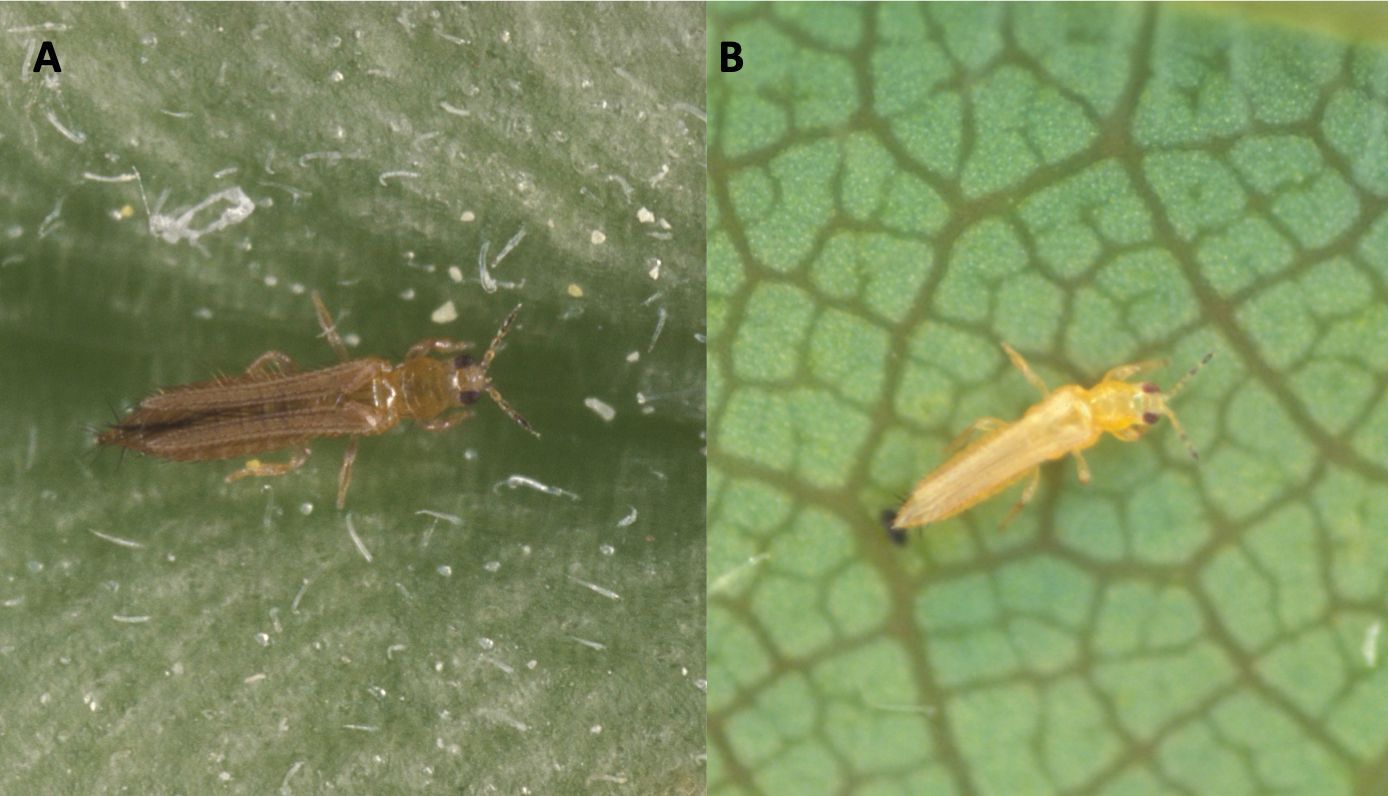
Credit: Lyle Buss, UF/IFAS
Damage
Eggs of the western flower thrips are inserted individually into tomato fruits, causing dimples sometimes surrounded by a white area. Heavy dimpling can result in cullout and downgrading, depending on market conditions. Dimpling is very rare on pepper and eggplant. The adults and larvae of both the western flower thrips and the melon thrips feed by sucking the contents of the epidermal cells of the plant. Feeding on fruit, primarily by the larvae, results in “flecking.” The western flower thrips is the key vector of Tomato spotted wilt virus. Tomato spotted wilt virus is a significant pest problem in northern Florida, but it is not a serious problem in central and south Florida, although problems sometimes occur on late-planted fruiting vegetables. Melon thrips damages eggplant, but tomatoes are not affected.
Chilli thrips Scirtothrips dorsalis
http://entnemdept.ufl.edu/creatures/orn/thrips/chilli_thrips.htm
Description and Biology
Contrary to western flower thrips and melon thrips, chilli thrips are most commonly found on leaves—leaf litter or on the axils of leaves—or under the calyces of flowers and fruits. They are the same size as other thrips (1/16 inch long), with a pale body, dark wings, and dark spots forming incomplete stripes that appear dorsally on the abdomen (Figure 7). Eggs are inserted inside leaf tissue and hatch after 2 to 7 days. Larvae and adults aggregate around the mid-vein of the host leaf.
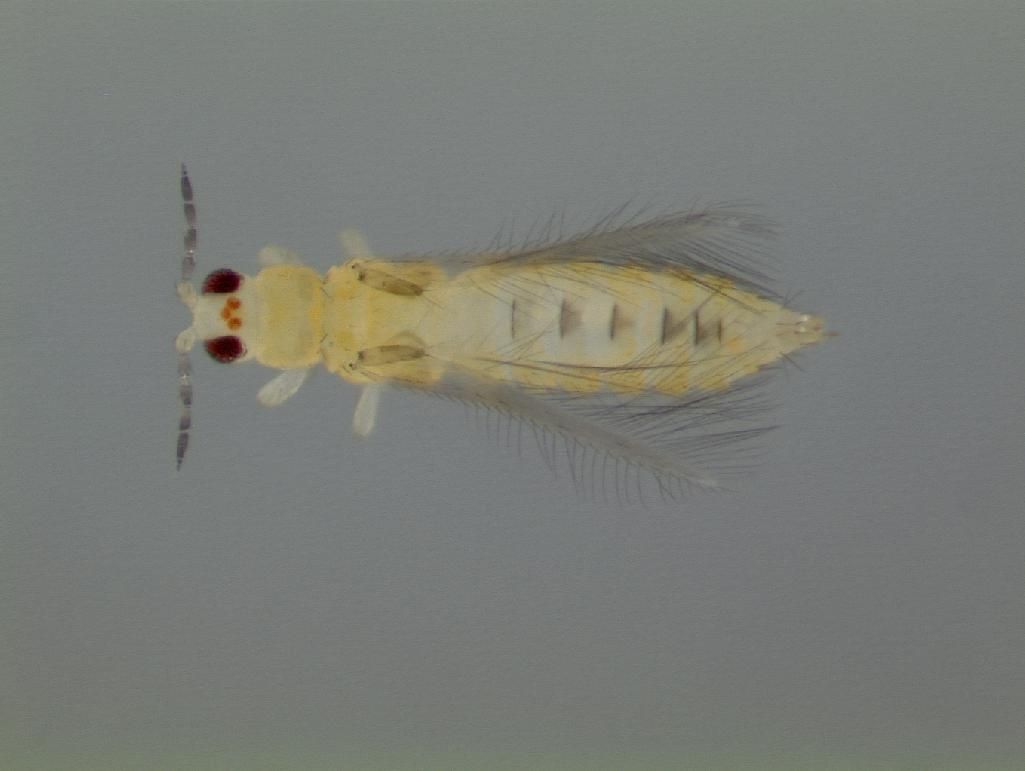
Credit: Lyle Buss, UF/IFAS
Damage
Chilli thrips are important pests of tomato, pepper, and eggplant. Chilli thrips cause damage by sucking nutrients from leaf tissues, leading to necrosis. Chilli thrips create feeding scars, distortions of leaves, and discolorations of buds, flowers, and young fruits. Feeding on the bud fruit leads to calyx softening, which causes premature falling of fruits.
Eastern Flower Thrips, Frankliniella tritici, Florida Flower Thrips, Frankliniella bispinosa, and Tobacco Thrips,Frankliniella fusca
http://entnemdept.ufl.edu/creatures/VEG/THRIPS/Frankliniella_tritici.html
http://entnemdept.ufl.edu/creatures/VEG/THRIPS/Frankliniella_bispinosa.htm
http://entnemdept.ufl.edu/creatures/VEG/THRIPS/Frankliniella_fusca.htm
Description and Biology
The eastern flower thrips is roughly the same size as the western flower thrips but the body is yellow. Adults examined at high magnification may be distinguished from other Frankliniella species found in Florida by a combination of diagnostic features described in detail in http://entnemdept.ufl.edu/creatures/VEG/THRIPS/Frankliniella_tritici.html. Eastern flower thrips is the most common thrips in northern Florida. It does not occur in central and south Florida, where the Florida flower thrips is the most common. Both species have life cycles similar to western flower thrips and melon thrips. Adults of the eastern flower thrips and the Florida flower thrips are not associated with dimpling or flecking, even when their numbers exceed 15 or more per flower. Further, their reproduction on fruiting vegetables is much less than the western flower thrips, and the potential for larval “flecking” damage is minimal. Populations of these native species are considered beneficial because they outcompete western flower thrips. The tobacco thrips is another species native to Florida. It occurs rarely in fruiting vegetables, and usually in very low numbers.
Damage
Heavy infestations cause silvered or bronzed leaves, stunted leaves and terminals, and scarred and deformed fruit. On peppers, fruit scarring emanates from the stem end following crevices between locule lobes (bumps on fruit bottom). Foliar damage may also be severe. However, apart for heavy infestation control of these thrips species is not recommended.
Table 4. Thrips management.
Vegetable Leafminer, Liriomyza sativae, L. trifolii
http://entnemdept.ufl.edu/creatures/veg/leaf/vegetable_leafminer.htm
Description and Biology
The adult is approximately 1/8 inch long with a black head, a yellow patch between the eyes, a black thorax, and a tube-like “ovipositor” at the end of the abdomen that the female vegetable leafminer uses to puncture the upper leaf surface for egg laying (Figure 8). The white, oval egg is inserted in the leaf tissue, but many punctures (called stipples) are feeding sites that do not contain eggs. The larva, a yellow maggot with black, sickle-shaped mouth hooks, feeds between the upper and lower leaf surface for approximately seven days, leaving a serpentine mine (Figure 9) containing a string of black frass (fecal matter). The mature larva exits from the mine and falls to the ground or plastic mulch where it molts to a pupa within a golden brown, barrel-shaped, ribbed puparium from which the adult emerges in seven to 14 days. Generation time is 15–28 days depending on temperature.
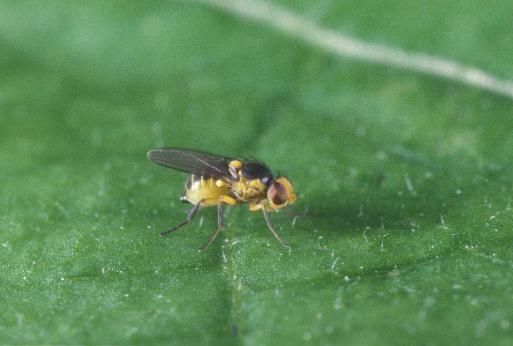
Credit: Lyle Buss, UF/IFAS
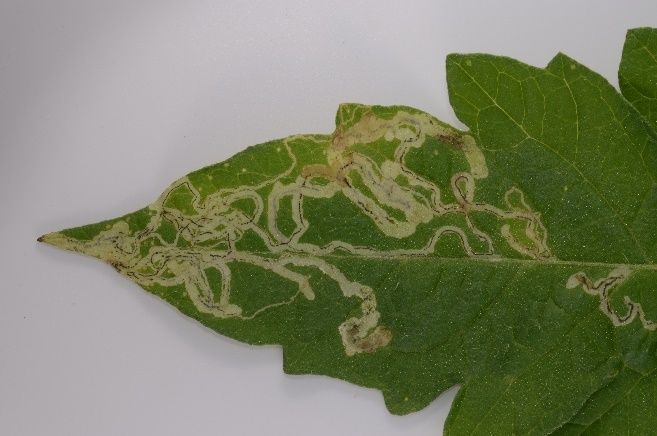
Credit: Lyle Buss, UF/IFAS
Damage
Leafminers reduce photosynthetic area on leaves and may provide entry points for foliar pathogens. Heavily damaged leaves become necrotic, exposing fruit to sunscald. Vegetable leafminer may be an important pest of tomato in south and central Florida but is only an occasional pest in north Florida. It is not usually a serious pest of pepper or eggplant.
Table 5. Tomato leafminer management.
Tomato Pinworm, Keiferia lycopersicella
http://entnemdept.ufl.edu/creatures/veg/tomato/tomato_pinworm.htm
Description
The adult is a small gray moth (wingspan about 1/2 inch) with a reddish-brown, mottled head and thorax. Eggs are oval, pale yellow to orange, and usually deposited singly or in groups of two to three on lower surfaces of foliage. Larvae (Figure 10) are purplish-gray, 3/8 inch long at maturity, and found inside blotch mines, leaf folds, or fruit, usually around the stem attachment. The pupa is formed in a silken cocoon covered with sand particles near the soil surface or on the plastic mulch.
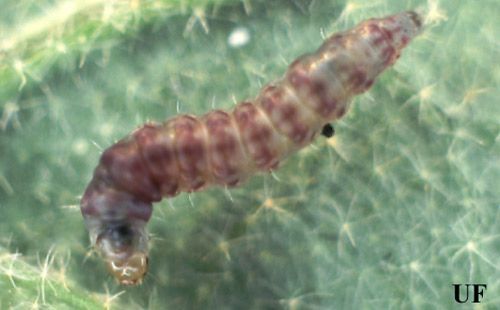
Credit: James Castner, UF/IFAS
Biology
Moths are most active at dusk. The female emits an odor, or pheromone, which attracts males from long distances downwind for mating. After hatching, first instars spin silk over themselves and tunnel into the leaf. Third and fourth stages fold or tie leaves or feed in stems or fruit. The pupal stage can last 1 to 4 weeks. Total generation time varies from 21 to 67 days depending on temperature. Seven to eight overlapping generations a year occur in south Florida.
Damage
The tomato pinworm feeds only on solanaceous plants such as tomato, eggplant, and potato. Pepper is not a host. Heavy feeding on foliage may cause defoliation, but damage to fruit is usually the worst consequence of tomato pinworm infestations. Damaged fruits are contaminated with insect parts, silk and frass, and may rot from introduction of pathogens. The tomato pinworm is an important pest in the spring in south and central Florida and summer or late fall in north Florida, especially if populations built up during the preceding season.
Table 6. Tomato pinworm management.
Tomato Fruitworm (Corn Earworm), Heliocoverpa zea
Description
The wingspan is about 1.5 inches. The forewing of the adult male is cream-colored with an orange or olive cast; the female is light yellowish-brown with indistinct vertical lines. Eggs are waxy, white, dome-shaped, and ribbed with a flat base. They are deposited singly on the undersides of leaves or flower petals. Larvae (Figure 11) can vary in color from light green or pink to brown or nearly black and are lighter underneath. The body is marked with lengthwise alternating light and dark stripes. Spines have raised dark areas at their bases.
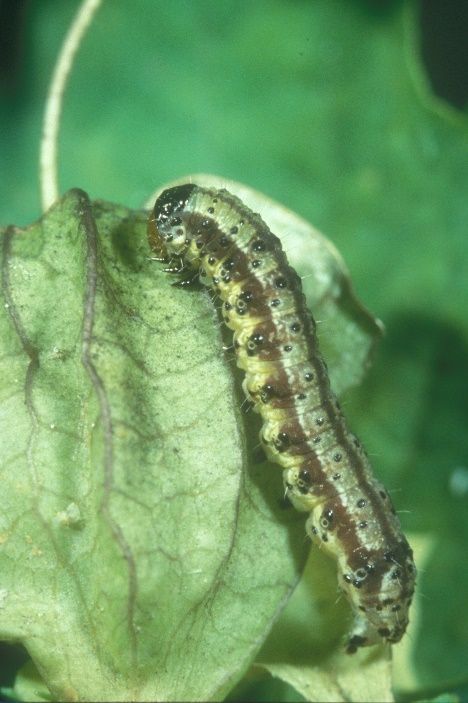
Credit: Lyle Buss, UF/IFAS
Biology
Adults are active at night. Eggs hatch in 2–3 days and the larval stage lasts 14–21 days. Larvae move to green fruit soon after hatching, and they bore deeply into the fruit. Tomato fruitworms pupate in the soil; the adult emerges in 7–14 days.
Damage
Larvae chew large, deep holes in tomato fruit, especially at the stem end. They occasionally feed on foliage. Eggplant and pepper fruit may also be damaged by tomato fruitworm.
Table 7. Tomato fruitworm management.
Southern Armyworm, Spodoptera eridania
http://entnemdept.ufl.edu/creatures/veg/leaf/southern_armyworm.htm
Description
The adult has about a 1.5-inch wingspan, and the front wing is streaked with cream, gray, light brown, and black; the hindwing is white with some dark brown on the margins. Eggs are laid on the undersides of leaves in large masses of 100 to 200 and covered with a felt-like mat of scales. Eggs hatch in 3–4 days, yielding dark larvae with two yellowish lateral lines interrupted by a large black spot on the first abdominal segment (Figure 12). Large larvae have two rows of dark triangles on the dorsal surface. The generation time is 29–35 days. Southern armyworm is the most common armyworm pest of tomato in south and central Florida but is only an occasional pest in north Florida.
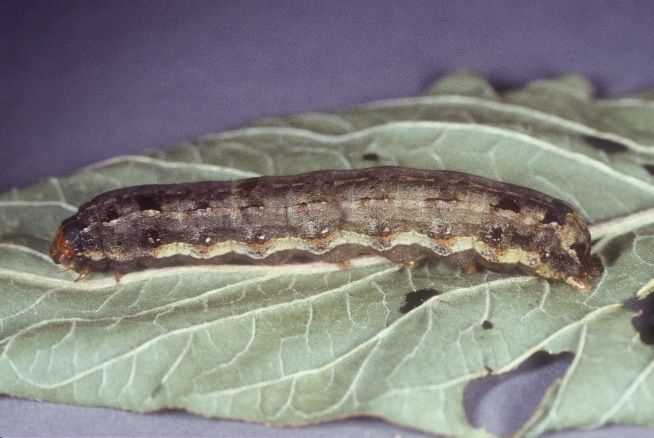
Credit: Lyle Buss, UF/IFAS
Beet Armyworm, Spodoptera exigua
http://entnemdept.ufl.edu/creatures/veg/leaf/beet_armyworm.htm
Description
The adult is smaller than southern armyworm (wingspan one inch), and the front wing is light brownish gray with indistinct lines; the hindwing is white. Egg masses are also smaller than those of the southern armyworm, usually numbering 50–75 eggs but are otherwise similar. Larvae (Figure 13) are generally green, mottled with white spots, 1–1¼ inch long at maturity, and often with a small black spot above the second pair of true legs. Generation time is 25–35 days. Tomato is not a preferred host for beet armyworm, but the insect may occasionally reach damaging levels anywhere in the state. Pepper is a preferred host, and larvae may feed on buds and leaves together or bore into fruit. The beet armyworm is more difficult to control with insecticides than the southern armyworm.
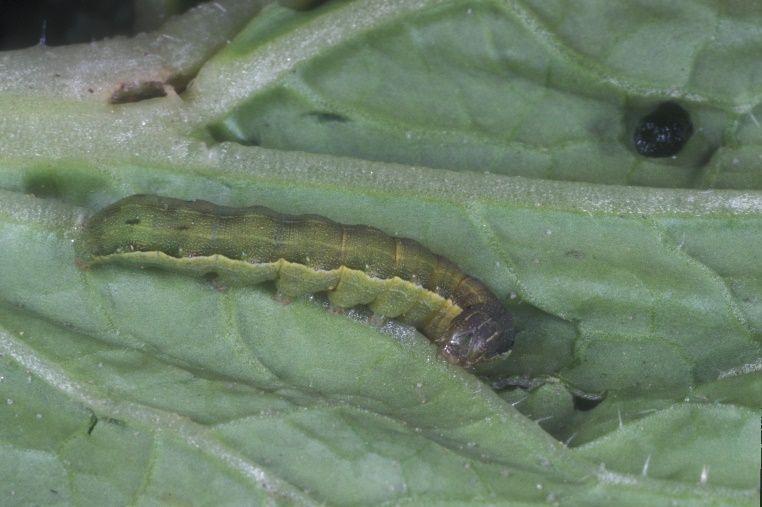
Credit: Lyle Buss, UF/IFAS
Yellowstriped Armyworm, Spodoptera ornithogalli
http://entnemdept.ufl.edu/creatures/veg/leaf/yellowstriped_armyworm.htm
Description
The adults and eggs are similar to those of the southern armyworm. Yellowstriped armyworm (Figure 14) mature larvae have a brownish band dorsally with a faint white line at the center. There are black triangular markings along each side with a distinct yellow or white line below. A dark line runs laterally through the area of the spiracles, and below this is a pink or orange band. The head bears a light-colored inverted V on the face. The yellowstriped armyworm is a serious pest in north Florida during the fall but is rarely present in south and central Florida.
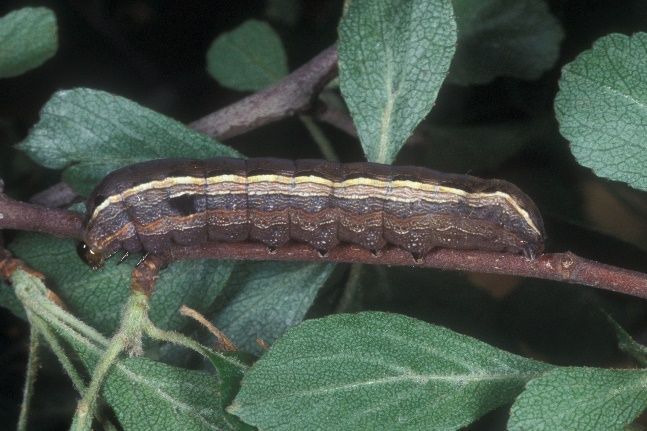
Credit: Lyle Buss, UF/IFAS
Table 8. Management of beet, southern, fall, and yellowstriped armyworms.
Pepper Weevil, Anthonomus eugenii
http://entnemdept.ufl.edu/creatures/veg/beetle/pepper_weevil.htm
Description
The adult (Figure 15) is a 1/6-inch-long black or gray beetle with a long snout (proboscis) and elbowed antennae. Larvae (Figure 16) are tiny, legless grubs found inside the pepper fruit. This is not a pest of tomato or eggplant.
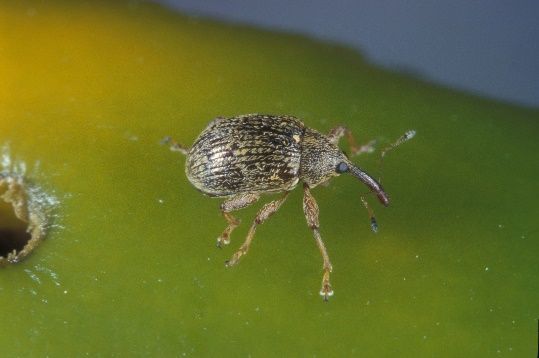
Credit: Lyle Buss, UF/IFAS
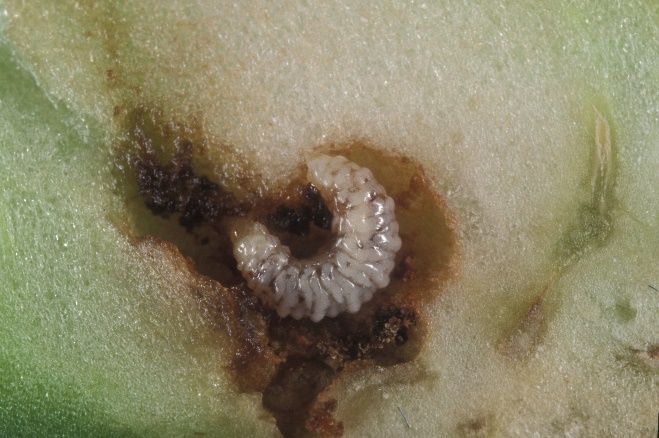
Credit: Lyle Buss, UF/IFAS
Biology
Adults use the mandibles at the end of the proboscis to feed on leaf or flower buds. Females also use the mandibles to bore small holes into developing fruit or flower buds. Each hole is plugged with frass (fecal matter) after an egg is deposited. A tiny, legless grub hatches from the egg and eats its way to the seed core of the fruit. It feeds on seeds and pulp, passing through the larval instars. Pupation takes place inside the fruit within a small cell created by larval feeding. The emerging adult may feed within the fruit before escaping through a circular hole chewed in the wall.
Black nightshade serves as a secondary host and maintains the pepper weevil when farmland is fallow. Because development times decrease as temperature increases and because adults migrate readily from old fields to new plantings, populations can build up during the growing season to peak in later spring plantings.
Damage
Damaged fruit become contaminated by insect parts, frass, and rotted tissue, and eventually fall from the plant.
Table 9. Pepper weevil management.
Two-spotted spider mite, Tetranychus urticae
Description and Biology
Two-spotted spider mites are 1/50 inch long, with a green-yellow translucent color. Adults (Figure 17) are eight legged, whereas the first immature stage has only three pairs of legs. The two large spots in the body are accumulated waste, so may not be present during early stages. Two-spotted spider mites complete development in 5–20 days. The adult female lives 2–4 weeks and can lay several hundred eggs during her life. The two-spotted spider mite produces a web containing the eggs that hatch after 3 days.
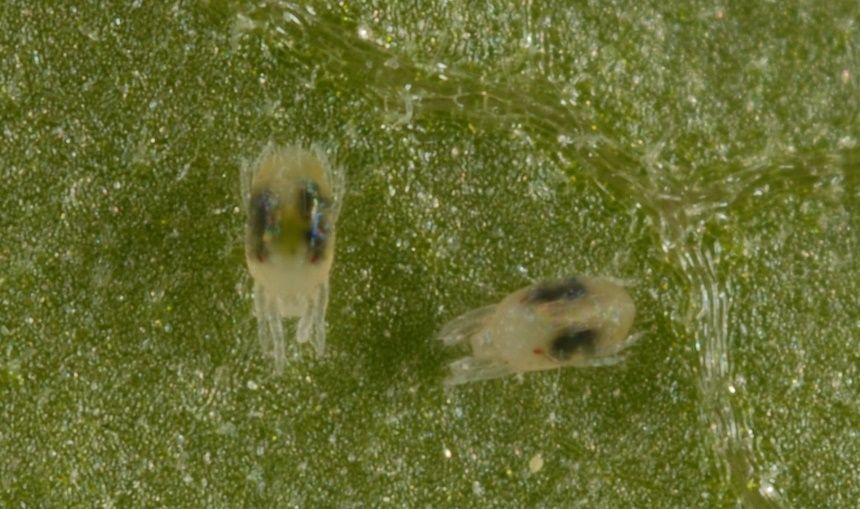
Credit: Lyle Buss, UF/IFAS
Damage
Two-spotted spider mites are major pests of tomato and eggplant. In tomato, they occur mostly at the end of the season under relatively hot, dry conditions. Use of some insecticides, especially pyrethroids can cause two-spotted spider mite outbreaks. These spider mites live mainly on the undersides of leaves and damage the plant by feeding with their piercing-sucking mouthparts. Spider mite feeding causes yellowing of the leaves that eventually die and drop from the plant. Loss of leaf surface area and yellowing reduce photosynthesis and the energy available to produce mature fruit. High spider mite densities have significantly decreased tomato yield. Spider mites can also cause direct damage to tomato fruit by producing a cosmetic blemish known as gold fleck that decreases marketability of the tomatoes.
Table 10. Spider mite management.
Broad Mite, Polyphagotarsonemus latus
Description and Biology
Adults (Figure 18) are 1/100 inch long, white, eight-legged mites usually most numerous on the underside of young foliage. Males sometimes carry females “piggyback." Nymphs are similar though somewhat smaller than adults. Eggs are about 1/4 the size of adults, round with white, opalescent spots, and glued to the plant surface. Generation time may be as short as 5 days, depending on temperature.
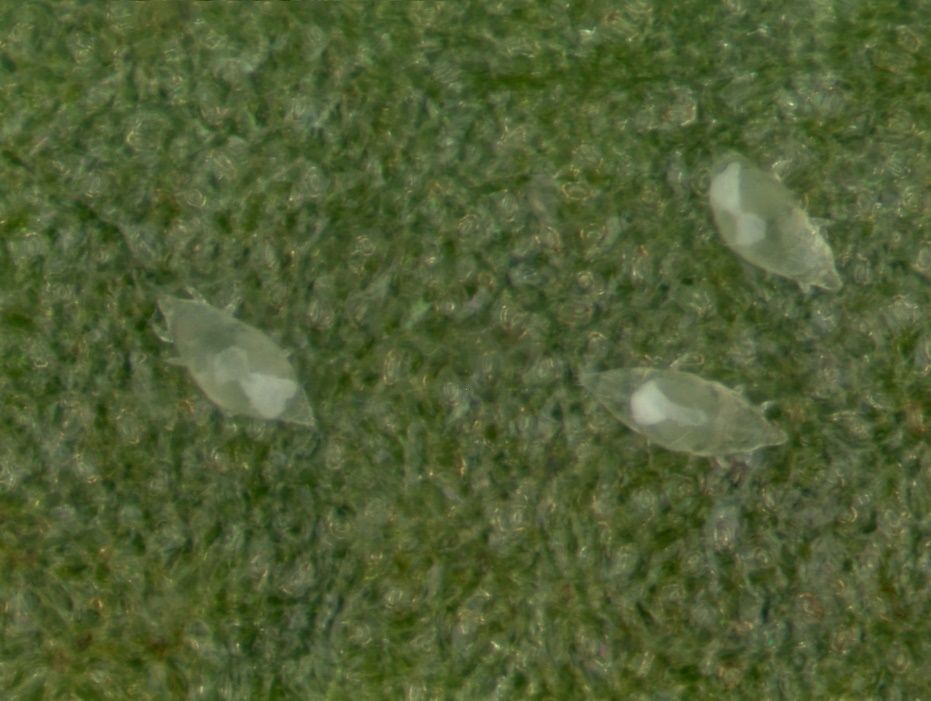
Credit: Lyle Buss, UF/IFAS
Damage
In peppers, broad mite feeding distorts plant tissue, causing leaves to become thickened and narrow, giving them a “strappy” appearance. Heavy feeding causes flower abortion and dark, smooth russeting of fruit. Infestations are often spotty, but may become more generalized, especially in late fall. Broad mite is a major pest of pepper, tomato, and eggplant.
Table 11. Broad mite management.
Colorado Potato Beetle,Leptinotarsa decemlineata
http://entnemdept.ufl.edu/creatures/veg/leaf/potato_beetles.htm
Description
Adults (Figure 19) have 10 lengthwise black stripes on yellow-orange wing covers and are approximately 3/8 inch long by 1/4 inch wide. They are distinctly convex in shape. Clusters of 10 or more yellow to orange spindle-shaped eggs are placed on the undersides of leaves. The larvae are humpbacked, red to orange, and have two rows of black spots on each side of their soft bodies.
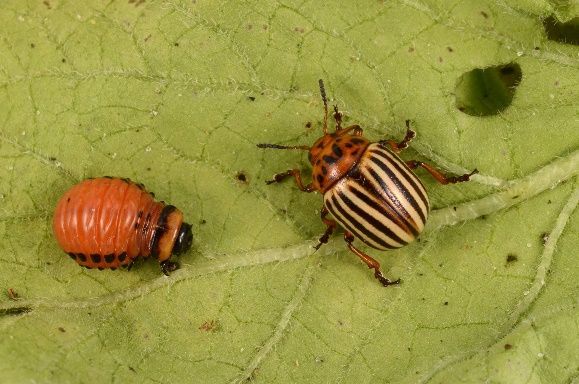
Credit: Lyle Buss, UF/IFAS
Biology
Colorado potato beetle is primarily a pest in the northern half of the state. Adults overwinter in debris around the edges of fields planted the previous season with potatoes, eggplant, or tomatoes. In the spring, they lay eggs in clusters of 10–40 that hatch in 3–7 days, depending on temperature. Females can deposit over 300 eggs during a 4- to 5-week period. Larvae complete 4 instars while feeding on leaves for 2–3 weeks and drop to the soil to pupate. New adults emerge from the soil 5–10 days later, or longer, depending on temperature.
Damage
Colorado potato beetle infests primarily potatoes, eggplant, and tomato but will also feed on peppers, tobacco, and solanaceous weeds, such as nightshade, horse-nettle, and ground cherry. The adults and larvae are voracious leaf feeders and will totally defoliate plants.
Table 12. Colorado potato beetle management.
References
Boyd, N. S., E. J. McAvoy, C. F. Miller, J. Desaeger, G. E. Vallad, and P. B. Williams. 2020. Vegetable Production Handbook of Florida: Chapter 13. Pepper Production. HS-732. Gainesville: University of Florida Institute of Food and Agricultural Sciences. https://edis.ifas.ufl.edu/cv130
Freeman, J. H., E. J. McAvoy, N. S. Boyd, R. Kanissery, H. A. Smith, J. Desaeger, G. E. Vallad, and P. B. Williams. 2020. Vegetable Production Handbook of Florida: Chapter 18. Tomato Production. HS-739. Gainesville: University of Florida Institute of Food and Agricultural Sciences. https://edis.ifas.ufl.edu/cv137
Gillett, J. L., H. N. HansPetersen, N. C. Leppla, and D. D. Thomas. 2006. Grower’s IPM Guide for Florida Tomato and Pepper Production. Gainesville: University of Florida Institute of Food and Agricultural Sciences. https://ipm.ifas.ufl.edu/Agricultural_IPM/Growers_IPM_Guide_for_Florida_Tomato_and_Pepper_Production.html
McAvoy, E. J., N. S. Boyd, P. D. Roberts, J. Desaeger, J. Qureshi, and P. B. Williams. 2020. Vegetable Production Handbook of Florida: Chapter 18. Eggplant Production. HS-726. Gainesville: University of Florida Institute of Food and Agricultural Sciences. https://edis.ifas.ufl.edu/cv124
Schuster, D. J., and H. A. Smith. 2015. Scouting for Insects, Use of Thresholds, and Conservation of Beneficial Insects on Tomatoes. ENY-685. Gainesville: University of Florida Institute of Food and Agricultural Sciences. https://edis.ifas.ufl.edu/in482
Smith, H. A., P. A. Stansly, D. R. Seal, E. McAvoy, J. E. Polston, P. R. Gilreath, and D. J. Schuster. 2018. Management of Whiteflies, Whitefly-Vectored Plant Virus, and Insecticide Resistance for Tomato Production in Southern Florida. ENY-735. Gainesville: University of Florida Institute of Food and Agricultural Sciences. https://edis.ifas.ufl.edu/in695